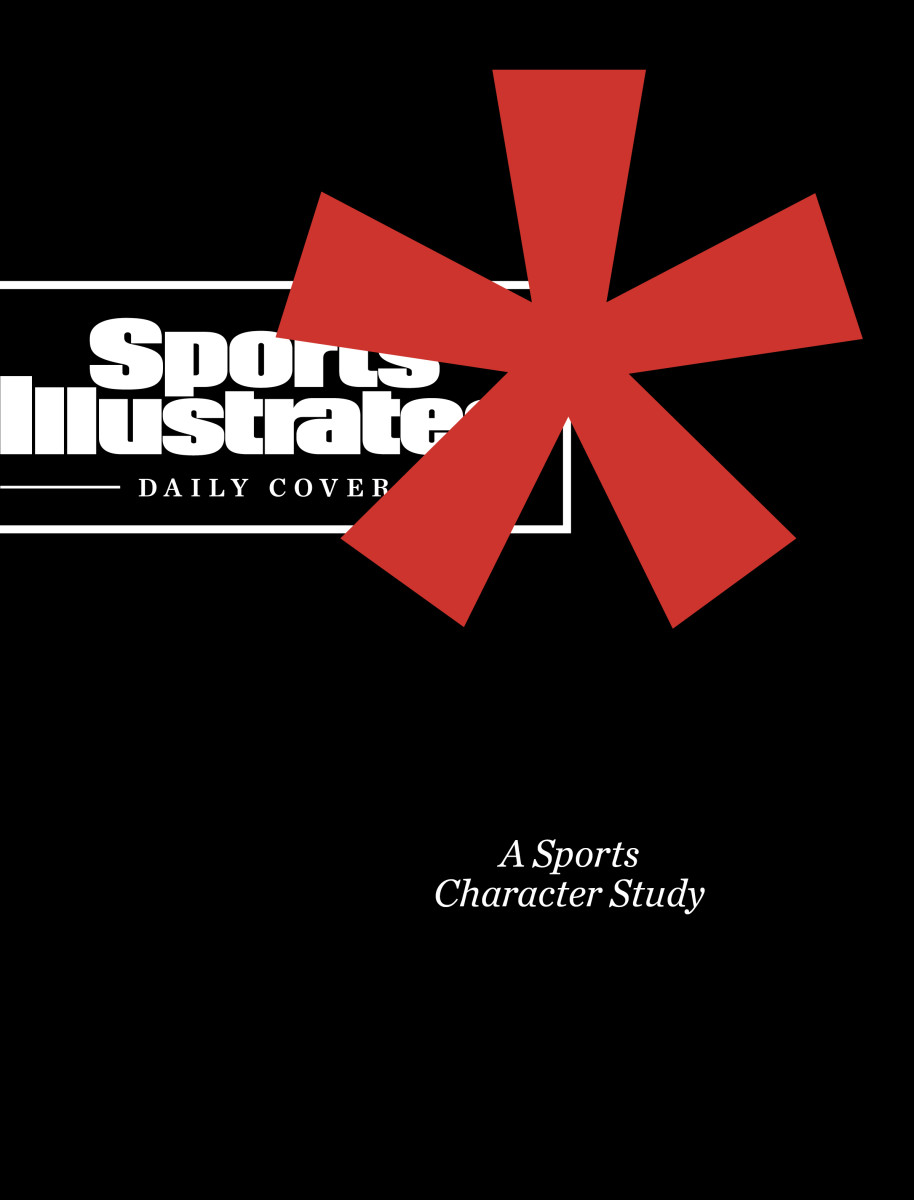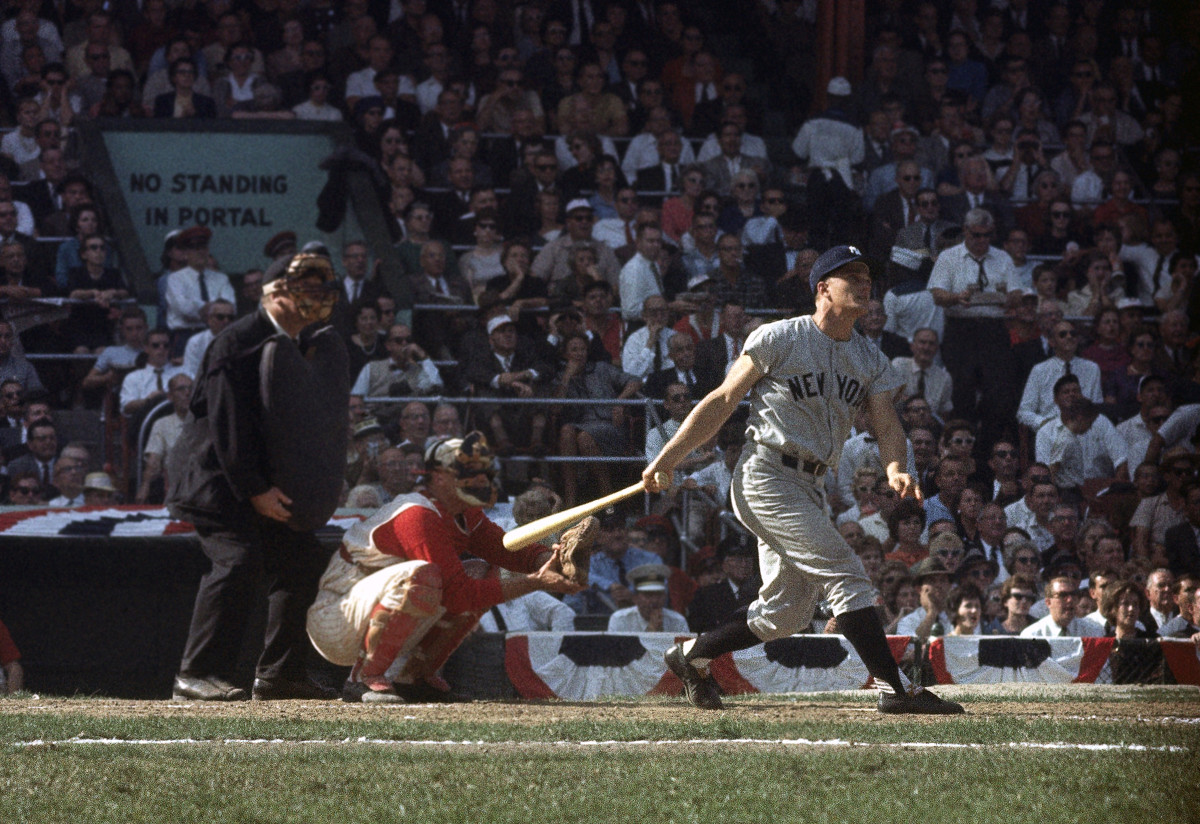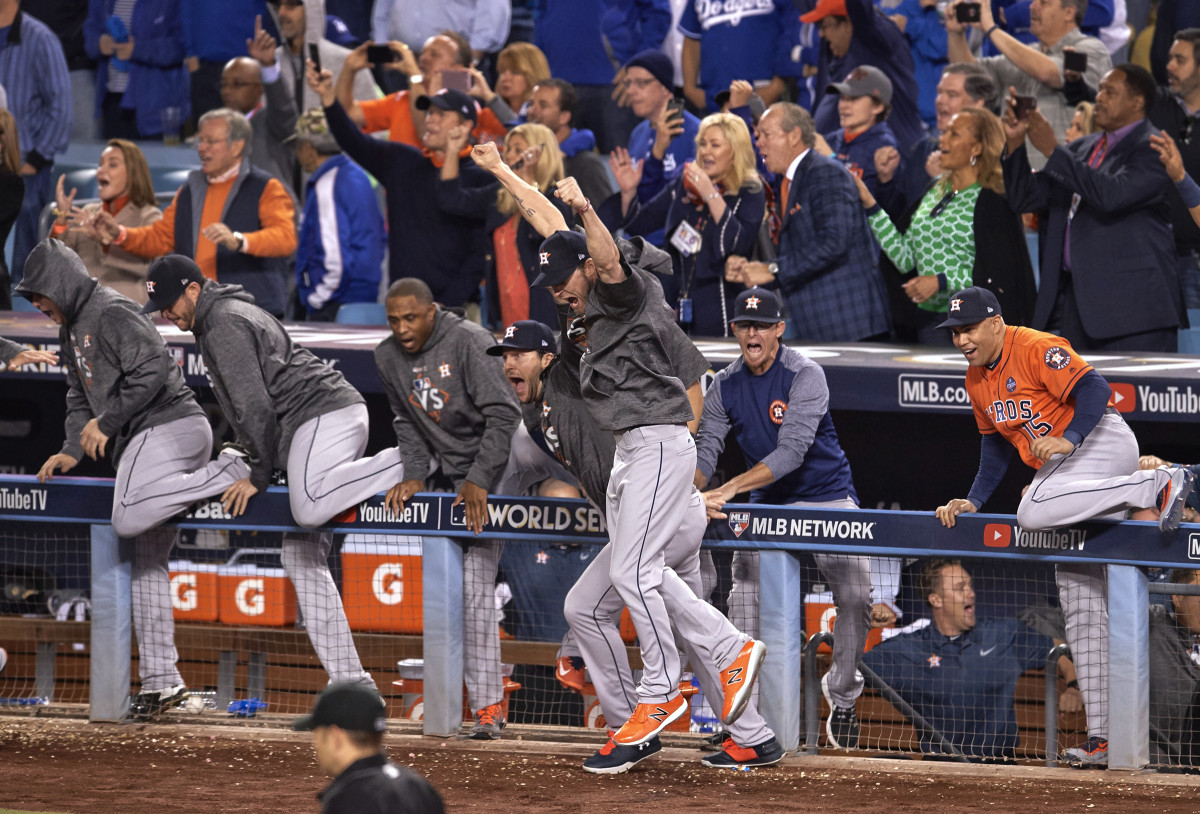The Faults in Our Tiny, Little Sports Stars
An asterisk is a small star; it shares a root with asteroid, astronomy and—to the delight of T-shirt makers—the Houston Astros. On the 1955 Major League Baseball schedule, in newspapers, an asterisk was affixed to the date of each night game, all those little stars evoking an evening sky in print. But the sun is also a star, and the asterisk more often behaves like that celestial sphere, brightening some lives—denoting, for example, high honors in a newspaper’s roll call of graduates—and casting others into shadow, as an asterisk did 60 years ago this summer, to Roger Maris.
An asterisk might direct a reader to a footnote, insisting that there is more to this story. (And there is more to this story—read on.) During the coronavirus pandemic, every team has been at risk of being asterisked. “This whole year deserves an asterisk,” Serena Williams said of 2020, to which a weary world replied: Amen. And also: No s***. Asterisks are sometimes used as fig leaves to disguise profanity in print.

Today, the asterisk is frequently deployed as a raised eyebrow, intended to downgrade some athletic achievement. “Any team that gets it done this year,” Shaquille O’Neal told USA Today last May of the NBA’s title contenders, “there’s going to be an asterisk on that championship.” And he was not alone in such thinking. After the Heat lost to the Lakers in the bubble-wrapped 2020 NBA Finals, Miami president Pat Riley said, “There will always be that asterisk.” (There won’t.) Under fire for a perceived dig, he later clarified that the Heat’s loss, not the Lakers’ win, would have an asterisk next to it, accounting for their injuries. (It wouldn’t.) Likewise, the Dodgers’ World Series title in ’20 didn’t carry an asterisk, just as the Astros’ ill-begotten win of ’17 does not literally bear an asterisk in some mythical record book, an illuminated manuscript that scholars blow the dust off each year.
Rather, the asterisk is a state of mind, a mental typography that delegitimizes authentic champions while wrist-slapping genuine cheats. An imaginary asterisk is about the only price that Astros players paid for their sign-stealing shenanigans. But if the asterisk has largely become an ignominious signifier in sports, for most of history it has been much more than that.
“Asterisks are used in the player rosters to indicate the number of varsity letters won; in schedules to show the home games; in series scores between rival schools to denote games played in cities which usually are not hosts to the teams; and in various other ways in listing season statistics.”
That was Frank Blair, sports editor of the Long Beach (Calif.) Press-Telegram, writing in 1952 while employing another typographical black sheep: the semicolon. Asterisks, Blair noted, “must not go away and leave one dangling in mid-air. An asterisk must have a footnote somewhere, explaining what it’s all about.”
What is the asterisk all about and why should anyone care about it? Twinkle, twinkle, little star. How I wonder what you are.
***
The asterisk is a drama queen, especially when clustered, in books and in magazine stories, as a cliffhanging break in the text. Visually it gives the eye a rest, allows the reader to stargaze for a moment, as you’re invited to do now. Look up at the stars.
Commas give us pause, too, but not in the way that those three asterisks just did. “We had no right to speak of the comma as this most timorous piece of punctuation,” the sometimes-sportswriter Heywood Broun wrote in 1922. “It does not stand at the bottom of the list. The greatest coward is the asterisk.” For at least 99 years, then, the asterisk has been somewhat disreputable.

If an asterisk were applied to Broun’s name in the paragraph above, it would direct you to a note at the foot of this page, and that footnote would say that Heywood Broun was the father of the CBS sports commentator Heywood Hale Broun, who played himself in the 1968 movie The Odd Couple. For a scene filmed in the Shea Stadium press box during a staged Mets-Pirates game, Broun is seen clapping Oscar Madison (played by Walter Matthau) on the back and shouting, “A triple play! The greatest fielding play I ever saw and you missed it!” Madison has been on the phone, taking a call from his roommate, Felix Ungar (Jack Lemmon), oblivious to Pittsburgh’s Bill Mazeroski’s grounding out in the background (Boyer-to-Buchek-to-Kranepool).
A second footnote, appended to the phrase “A triple play!,” would let the reader know that an unassisted triple play really did happen in the summer of The Odd Couple’s release, turned by Senators shortstop Ron Hansen, against Cleveland on July 30, 1968. And a third asterisk, tacked on to Mazeroski’s name, would note that the filmmakers originally wanted Roberto Clemente to be the hitter in that scene, though the Pirates’ right fielder was much too fast to plausibly hit into a triple play. And this is the trouble with the asterisk: It doesn’t know when to shut up.
The asterisk is a know-it-all who says: *There have only been 15 unassisted triple plays in major league history. But the asterisk is also a narc who whispers: *Wind-aided whenever an exceptionally fast runner appears to set a record. Worse, the asterisk is a nothing-to-see-here grifter trying to slide something past you in small print: *Batteries not included. Or: *Professional driver on closed course. Or: *Side effects may include nausea, diarrhea and death.
With sports in 2021 the asterisk is almost exclusively a drag—a badge of dishonor, a scarlet letter. (The logo for the Red Hot Chili Peppers, designed by lead singer Anthony Kiedis, is perhaps the most inglorious of marks; it is a scarlet asterisk.) Of the U.S. Open tennis tournament held in September ’20, The New York Times asked: “Will it really be the Asterisk Open?” Golf Digest: “Should there be a Masters asterisk in 2020?” And an ESPN headline: “NBA Bubble Asterisk?” The answer to every one of these rhetorical questions was No. And yet the asterisk hangs over the heads of athletes, like the ceiling fan it resembles.
It calls into question achievements, challenges legitimacy. President George W. Bush was depicted as a human asterisk in Doonesbury comic strips after the disputed presidential election of 2000. Years earlier, when his father, George H.W. Bush, received less than 1% of the vote in a poll of candidates running in the 1980 election, his total was reported as an asterisk. Expressed as a typographical equation, it looked like this: * < 1%.
But no man became a human asterisk quite like Ford Frick.
***
Frick was baseball’s commissioner when an asterisk was applied to Maris’s home run record, 60 years ago this summer, in 1961. “Commissioner Frick makes the rules,” Maris said during that 162-game season in which he broke Babe Ruth’s single-season home run record—a record that Ruth had set in just 154. “If all I’m entitled to is an asterisk, it will be alright with me.”
Frick, in fact, never ruled that an asterisk must be applied to Maris’s record. What he did decree, though, was colored by a friendship with Ruth—he ghost-wrote Babe Ruth’s Own Book of Baseball—and possibly by the passing of Ty Cobb in a Georgia hospital, who held so many baseball records accrued over 154-game seasons. Cobb died on July 17, 1961, the very day that Frick held the spirited press conference where he issued his famous edict: “Any player who may hit more than 60 home runs during his club’s first 154 games would be recognized as having established a new record. However, if the player does not hit more than 60 until after his club has played 154 games, there would have to be some distinctive mark in the record books to show that Babe Ruth’s record was set under a 154-game schedule and the total of more than 60 was compiled while a 162-game schedule was in effect.”
Some distinctive mark. The only mention of an asterisk in that press conference, Frick would maintain, was by New York Daily News columnist Dick Young, who said, “Maybe you should use an asterisk on the new record. Everybody does that when there’s a difference of opinion.”

“Dick and other writers have had a lot of fun with ‘asterisk’ stories over the years,” Frick wrote in his 1973 memoir. “But the honor is not mine. To Dick, a low obeisance for a clever line, with or without an asterisk.”
From 1961 on, the asterisk has been weaponized, though seldom on the page. As Frick noted: “No asterisk has ever appeared in the official record in connection with the Maris feat.” Indeed, there was no official record. No Baseball Encyclopedia. No baseball-reference.com.
If not for Young’s offhand suggestion, the “distinctive mark” Frick called for could have been anything. It might have been an obelisk (†), sometimes called a dagger. In academic writing, a first footnote is often an asterisk, a second footnote an obelisk (accounting for the children’s book characters beloved in Europe: Asterix and Obelix) and a third footnote, an obelisk with two crossings (‡).
Frick, given the choice, might have affixed to Maris’s record a circumflex (ˆ), a Dutch florin sign (ƒ) or whatever the hell this is (§). But most appropriately, Frick could have suggested—should have suggested—a dingbat (also known as a printer’s glyph or a spacer, which can be any visually interesting symbol, like this ❀). For that is what Frick became, in the press and in the public memory: the dingbat with the asterisk.
The commissioner’s memoir was called Games, Asterisks, and People*, a title that employed two upsetting pieces of punctuation: the asterisk and the Oxford comma. John P. Carvalho’s 2016 biography of Frick is called Frick*, that asterisk appended to the former commissioner, who died in 1978, for all eternity.
In 1985, Maris took the invisible asterisk to his grave. Six years later it was expunged—to the extent it ever existed—by commissioner Fay Vincent, after which Roger Maris Jr. said of his late father: “The only reason I ever felt there was an asterisk was to take away from what he accomplished in 1961.”
So Maris had 30 years with the asterisk and he has now had 30 years without one. But 1961 remains the continental divide, the time when the asterisk changed forever into something sinister. One year later in ’62, an advertising executive named Martin Speckter invented the interrobang. A combined question mark and exclamation mark (‽), it can be used to express anger and disbelief simultaneously, as when punctuating the modern-day locution, WTF?!
In the 21st century, when an athlete or team is impugned by an asterisk, an interrobang—Lance Armstrong‽—would better convey the feeling an asterisk has come to represent.
***
In the Grove Street Cemetery in New Haven, Conn., row upon row of graves are marked by obelisks and crosses, so that those buried beneath appear literally to be historical footnotes. The graveyard first welcomed the newly deceased in 1796, when it opened as a “city of the dead,” designed with avenues and cross streets. Among its permanent residents 225 years later are Eli Whitney, Noah Webster and Charles Goodyear, who gave the world vulcanized rubber (to the eternal gratitude of hockey players and their dentists) and without whom there would be no aerial coverage of Monday Night Football, if not for his eponymous blimp.

Grove Street Cemetery is also home to a Yale chemist named John Gamble Kirkwood, whose eminent career accomplishments are crammed onto his nearly six-foot-tall headstone, so chockablock full with achievement that it reads like the back of a Hall of Famer’s baseball card.
Kirkwood’s colleague, Lars Onsager, also lies eternally in Grove Street, directly next to Kirkwood. Onsager won the 1968 Nobel Prize in chemistry “for the discovery of the reciprocal relations bearing his name, which are fundamental for the thermodynamics of irreversible processes.” That’s not on his headstone, however. His headstone reads only:
Lars Onsager
1903-1976
Born Oslo, Norway
J. Willard Gibbs Professor
Nobel Laureate*
The asterisk was added later, by Onsager’s children. But an unpaired asterisk, like a single sock, is of no use to anyone, as Frank Blair, that sports editor in Long Beach, wrote nearly 70 years ago: “Readers have been known to have nervous breakdowns if they can’t find what an asterisk denotes.”
The matching asterisk in this case, a cheeky riposte to Kirkwood’s headstone, is at the bottom of Onsager’s granite slab. The footnote, in its entirety, reads:
*Etc.
***
Asterisks were proposed when NBA scoring records were distorted by the introduction of the three-point line, in 1979. And again when steroids disfigured baseball’s home run records in a way that Maris never had. And yet again when it was revealed that Armstrong’s seven consecutive Tour de France “wins” were aided by performance-enhancing drugs. (Instead, those titles were eventually stripped.) You’ll note the quotation marks of derision around wins, a typographical eye roll, which is what the asterisk has also become.

The asterisk is now a sports emblem, like the interlocking N and Y of the Yankees, whose one-time manager, Casey Stengel, liked to say, “You could look it up.” And you can, in Webster’s Dictionary:
as·ter·isk | The character * thought of as being appended to something (such as an athletic accomplishment included in a record book) typically in order to indicate that there is a limiting fact or consideration which makes that thing less important or impressive than it would otherwise be.
The sample sentence that Webster’s editors have chosen to illustrate this definition: “But the men’s triumph came with an asterisk: The Soviets, three-time gold medalists, had boycotted the Games.”
When the Astros won the 2017 World Series, using trash-can subterfuge, the asterisk provided meaningless answers to hard questions. Chief among them: Should their title be stripped? Major League Baseball decided that it should not; that for the players responsible, the mental asterisk would serve as punishment enough, in addition to the physical asterisks they faced daily on T-shirts, caps and signs. At spring training in 2020, a large asterisk, written in marker on poster board, was placed alongside the WORLD CHAMPIONS sign outside of the Astros’ Grapefruit League home, where it served to prick—one is tempted to say Frick—the team’s bubble of self-regard.
Gordie Howe long ago pointed out that Wayne Gretzky’s placement atop the all-time NHL scoring list failed to account for the six seasons that he—Howe—had played in the WHA; he called for an asterisk to be affixed to the mark. (The Great One, in deference to his childhood hero, thought it a great idea.) In 1990 when Penn State became the 11th team in a conference called the Big Ten, Illinois president Stanley O. Ikenberry said, “We may need to be the Big Ten with an asterisk.” And after the 1999 NBA season was shortened to 50 games, following a lockout, Lakers coach Phil Jackson suggested that whichever team won the championship, it should be awarded an asterisk as well as a trophy. During that Jackson-free Finals in San Antonio, a fan of the soon-to-be-champion Spurs held aloft a sign that read: PHIL CAN KISS MY *.
***
Ring Lardner was among the most esteemed writers of his age, on par with his good friend F. Scott Fitzgerald. “But [his standing] was always listed with reservations—with, in baseball’s statistical language, an asterisk,” Lardner’s biographer, Jonathan Yardley, wrote of his own subject’s regard. “And the asterisk was baseball itself.”
Baseball was Lardner’s literary milieu. And baseball, Fitzgerald wrote upon Lardner’s death, in 1933, that it was “a boy’s game, with no more possibilities in it than a boy could master, a game bounded by walls which kept out novelty or danger, change or adventure.”
That may be the worst description of baseball ever written by a great writer, but sportswriting has always had an asterisk applied to it. Even the first half of that compound word is a kind of asterisk, sports modifying writing in a way seldom meant as a compliment. Frank Deford said that whenever people heard he was a sportswriter, they assumed—wrongly, in his case—that he was more interested in the first half of that word than the second.

But Lardner’s baseball asterisk is no more deserved than Maris’s. Lardner’s stories speak for themselves, especially his Letters from a Busher, in which the fictional Jack Keefe, a pitcher in the White Sox farm system, writes a series of letters to his friend Al. Here’s one epistle, from Oakland, with Keefe writing about his manager:
He says And I noticed you taking your wind up when What’s His Name was on second base there to-day. I says Yes I got more stuff when I wind up. He says Of course you have but if you wind up like that with Cobb on base he will steal your watch and chain. I says Maybe Cobb can’t get on base when I work against him. He says That’s right and maybe San Francisco Bay is made of grapejuice. Then he walks away from me.
Ring Lardner was no more limited by sports than Ernest Hemingway was limited by war. In fact, Hemingway so admired Lardner that, when writing for his high school newspaper in Oak Park, Ill., he sometimes used the pen name Ring Lardner, Jr.
There would, in fact, be a real Ring Lardner, Jr.—Ring’s son—and he became a Hollywood screenwriter. That Ring Lardner won the Academy Award for Best Screenplay in 1943, for Woman of the Year, got blacklisted during the Red Scare of the 1950s and regained his career in the following decade, adapting a screenplay based on a novel about the Korean War by Richard Hooker, the joint pen name of former Army doctor H. Richard Hornberger and sportswriter W.C. Heinz. Both the novel and the film, each set in a Mobile Army Surgical Hospital, were called MASH.
And though Lardner would win his second Oscar with MASH, for Best Adapted Screenplay, he was reportedly furious with the film’s director, Robert Altman, who encouraged the ad-libbing that rendered Lardner’s script unrecognizable on-screen. Even the movie’s title would be subtly but significantly altered. When the picture was released in 1970, marketers at 20th Century Fox gave the movie—in print ads and posters—asterisks. M*A*S*H in turn became an enormously popular television series, the CBS finale of which drew a record television audience. On a Monday night in February 1983, those three asterisks were seen by more people—106 million—than any asterisks in history. They remain the biggest stars among these little stars, the last of the feel-good asterisks.
But back to the Ring Lardners. Both were accomplished writers, both saddled with asterisks. “We are made of star stuff,” the astronomer Carl Sagan famously said of our carbon-based species. We may be decorated by stars, like Michelin chefs, or bedeviled by them, like star-crossed lovers. But those little stars are not us. The fault, dear Brutus, is not in our stars, but in ourselves. If it’s true of our faults, it must also be true of our strengths, which no little star can diminish.
***
Typographical symbols evolve. They grow up. This guy—#—was once known as “number sign,” gracing We’re #1 foam finger across the 1970s. In the following decades, with the advent of automated telephone answering systems, it became the infuriating “pound sign,” as in Please press 1, followed by the pound sign. Now, the former pound sign has achieved global fame, renewed relevance and a youthful demographic, rebranded—rehabilitated—as the “hashtag.”
Such a metamorphosis may seem unlikely for the asterisk, but it has already begun. During the NCAA women’s national championship basketball game earlier this month, ESPN’s Holly Rowe reported that Stanford coach Tara VanDerveer said an asterisk would attach itself to whichever team won that night, given all the challenges posed by 2021. “In this case, a positive asterisk,” agreed play-by-play man Ryan Ruocco, “because it has required such incredible fortitude.”

Stanford’s women had spent 100 days playing, practicing and studying on the road during the coronavirus pandemic and when they won that championship game over Arizona, the “positive asterisk” pinned to them was a boutonniere, accessorizing a special occasion. Like the stars pinned to a general’s chest or adhered to a child’s test, Frick’s “distinctive mark” had become, for one night, anyway, a mark of distinction.
• The Unrivaled Arrival of Trevor Lawrence
• The Trade That Might Have Saved Caris LeVert
• The Year of the Opt-Out NFL Prospect
